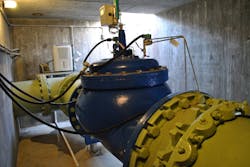Patoka Lake Regional Water & Sewer District (PLRWSD) serves 11 counties in southern Indiana with a population of around 130,000. Water is distributed though approximately 850 miles of pipe ranging in size from sizes 3 in. to 30 in. and includes numerous elevated towers and/or tanks in each district metered area (DMA). An intake structure located at Patoka Lake, a little over one mile from the water treatment plants, feeds the facilities. Sean Kluesner is operations manager and Jerry Allstot is the plant superintendent for the district.
The Solution
A recent plant upgrade designed by Midwestern Engineers nearly doubled the size of the treatment plant’s capabilities and increased the size of raw water pumps at the intake structure. With a complex network of pipes, booster-pumping stations, tanks and reservoirs required to move the water from the treatment facilities to customers, several Singer control valves were selected to maintain the pressure in each DMA.
To prevent surges when starting and stopping the pumps, PLRWSD selected two bypass pump control valves. These control valves are installed in a tee between the pump discharge and the check valve. The valve is normally open, and on pump startup, the valve discharges air, water and sand to waste. The open valve discharges all pump flow, and then, as the valve slowly closes, flow is smoothly transferred to the main line, increasing the pipeline flow without surges. When the valve is fully closed, all pump flow is in the pipeline with no control valve losses.
In addition, two 12-in. flow metering valves with internal drop check features, controlled by a multi-process control panels with touch panel interface (MCP-TP), were selected to be used downstream of the pumps. These valves were chosen for several reasons. First, they have an internal drop check feature that closes the valve should you have a reverse flow situation. This eliminates the need for a check valve downstream, as well as a hydraulic overriding pressure-reducing pilot to ensure the system does not over-pressurize downstream. However, the main reason for the flow metering valves being used in this application is that they have the ability to measure as well as control flow when partnered with the MCP-TP control panel. These features give the user the ability to program varying set points of flows during the day.
“Setting the set point is very easy,” said Ryan Spooner of Singer Valve. “Just type in a flow set point on the touch screen and the controller takes care of the rest.” This is especially cost-effective for lower flows during off-peak times of the day, as there is no shutting down of the pumps, which would add cost.
PLRWSD also needed a valve solution to handle the additional flows to multiple water plants equally. One option was to use an existing 14-in. valve and add another new 14-in. valve in a side-by-side arrangement using position control to drive open both valves equally. However, this was determined not to be the best solution, as each valve would not flow equally because of the varying length of pipe, location of the valves, and number of 90-degree bends before and after the valve locations. In addition, PLRWSD still is planning for a growing population, which this setup would not have accommodated.
[Visit Singer Valve's W&WD Storefront]
After much consideration, FloSource suggested a larger 24-in. control valve partnered with an EPC-4XF control panel and X156 position transmitter for valve position indication. The EPC-4XF’s main function is designed to complement a dual opening and/or closing solenoid configuration with quick and easy configuration for any single process application. The controller reads and compares the process feedback to the desired set point, then accurately positions the valve to bring the process variable towards the set point until they coincide using a proportional–integral–derivative control loop. The EPC-4XF is equipped the dual opening and/or closing solenoid configuration referenced above, and is equipped with an additional solenoid for shutoff and override.
The Results
Choosing the right valves for each application is critical, and having the ability to tweak each valve with various backup features and remote control options gives Patoka Lake the flexibility to manage its water distribution effectively. The upgrades will allow the utility to grow and welcome new residents with reliable water flow.


